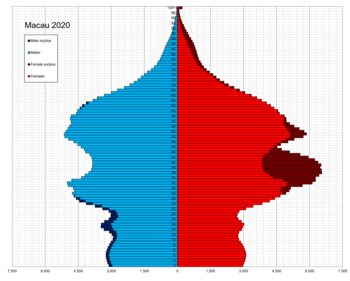This article needs additional citations for verification. (September 2020) |
| Demographics of Macau | |
|---|---|
 Population pyramid of Macau in 2020 | |
| Population | 635,293 (2022 est.) |
| Growth rate | 0.75% (2022 est.) |
| Birth rate | 5.5 births/1,000 population (2023 est.) |
| Death rate | 4.4 deaths/1,000 population (2023 est.) |
| Life expectancy | 84.98 years |
| • male | 82.09 years |
| • female | 88.02 years |
| Fertility rate | 0.58 children born/woman (2023 est.) |
| Infant mortality rate | 4.59 deaths/1,000 live births |
| Net migration rate | 3.15 migrant(s)/1,000 population (2022 est.) |
| Age structure | |
| 0–14 years | 14.41% |
| 15–64 years | 70.73% |
| 65 and over | 14.86% |
| Sex ratio | |
| Total | 0.9 male(s)/female (2022 est.) |
| At birth | 1.05 male(s)/female |
| Under 15 | 1.05 male(s)/female |
| 65 and over | 0.74 male(s)/female |
| Nationality | |
| Nationality | Chinese |
| Major ethnic | Han Chinese (88.7%) |
| Language | |
| Spoken | Cantonese (80.1%) |
| Part of a series on the |
| Culture of Macau |
|---|
 |
| History |
| Languages |
| Cuisine |
| Religion |
| Sport |

Demographic features of the population of Macau include population density, ethnicity, education level, health of the populace, economic status, religious affiliations and other aspects of the population.
Macau's population is 95% Chinese, primarily Cantonese and some Hakka, both from the nearby Guangdong Province. The majority of the remainder are of Portuguese or mixed Chinese-Portuguese ancestry. Some Japanese, including descendants of Japanese Catholics who were expelled by shōguns, also live in Macau.
The official languages are Portuguese and Cantonese Chinese. The residents commonly (85.7%) speak Cantonese, Mandarin is spoken by 3.2% at home, about 40% are able to communicate in standard Mandarin. English and Portuguese are spoken as a first language by 1.5% and 0.6% respectively, while English is widely taught as a second language. The other popular topolect is Hokkien (Min Nan), spoken by a small percentage of the population. The creole Macanese language (Patuá or Macaista Chapado) is almost extinct.